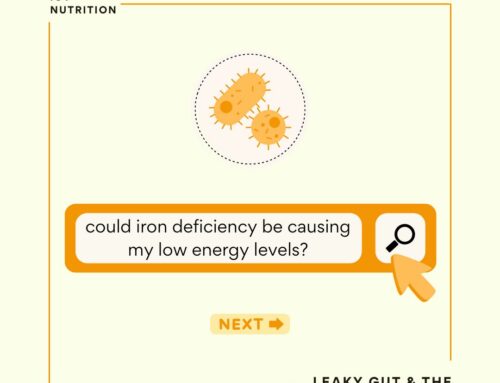Have you ever wondered why athletes seem so… healthy? You get the picture – they’re ripped, can run for miles, and can lift a superhuman amount of weight.
But that’s not all – their skin seems to glow, their energy levels are high, and they can mow down tons of food without digestive distress. Why is that?
Small compounds called short-chain fatty acids may be involved. Let’s take a look.
Recap: The Microbiome
To understand whole-body health, you must understand the importance of the microbiome. Hang on. We know this gets science-y – just stick with us.
The microbiome is an ecosystem of millions of microbes – like bacteria, yeasts, and even fungi – living within or on the human body. The term “gut microbiome” refers to the microbes inhabiting the GI tract (1).
At first glance, microbes living in the body might sound pretty gross, but they’re necessary for our survival (1).
Many of the microorganisms living within us benefit our bodies by regulating metabolism, helping us absorb vitamins from food, supporting our immune system, and much more (1).
The thing is, not all of the microorganisms in our microbiomes are helpful. Some are harmful. These harmful microbes can damage the gut barrier, increase inflammation, and wreak havoc on our metabolisms, hormones, immune systems, and even our mental health (2).
Plus, they can cause uncomfortable digestive issues like gas, bloating, and stool irregularity – no fun (2).
To minimize the gut damage and annoying symptoms the harmful microbes cause and maximize the benefits helpful microbes confer, we want lots of beneficial microbes and very few harmful microbes to live in our guts (1, 2).
In a healthy microbiome, there are many more beneficial microbes than harmful microbes (1, 2). The more beneficial microbes and the fewer harmful microbes there are, the healthier the biome is. There is also a wide variety of beneficial microbes in healthy microbiomes, which we call “microbial diversity” (3).
In an unhealthy microbiome, there are too many harmful microbes and not enough helpful microbes. There may also be a lack of microbial diversity. This state of imbalance is called dysbiosis (2).
So what does this have to do with athletes’ health? A healthy microbiome lays the foundation for proper digestion, a robust immune system, regulated energy levels, and much more (1).
Take a guess – what do you think the typical athlete’s microbiome looks like? Yep, it typically looks pretty good.
Athletes’ Microbiomes
Athletes tend to have robust microbiomes (4). They have more of the types of probiotic bacteria that:
- Improve the metabolism of fats and carbs (5)
- Lower inflammation (5)
- Increase the production of short-chain fatty acids (5)
Increase the production of short-chain what-what?
Short-chain fatty acids are nutrients that support the health of the intestines and the balance of the gut microbiome. Bacteria living in the colon produce them (6).
One type of short-chain fatty acid called butyrate is especially relevant.
The cells in your colon (the end of the large intestine) prefer butyrate as a fuel source. These cells tend to operate best when using butyrate for energy (7). Athletes tend to have high levels of butyrate in their guts (8).
About Butyrate
People with high levels of butyrate in their guts have:
- A regulated gut immune system (9)
- → improved tolerance to food
- → lowered levels of inflammation
- Better cellular health than those with low levels of butyrate
- Improved healing
- Less intestinal permeability than those with low levels of butyrate (10)
Low levels of butyrate are associated with (11, 12):
- Obesity
- Dysbiosis
- Intestinal permeability
- IBD
- Poor appetite regulation
- Food intolerances
Having enough butyrate is desirable. So how do you increase butyrate in your own gut? Check out part two to learn.
Thanks for joining us today! Tag us in photos of your digestive wellness journey on Instagram @igynutrition.
References
- https://www.sciencedirect.com/topics/immunology-and-microbiology/microbiome
- https://www.sciencedirect.com/topics/medicine-and-dentistry/dysbiosis
- https://www.sciencedirect.com/topics/medicine-and-dentistry/microbial-diversity#:~:text=Abstract-,Microbial%20diversity%20can%20be%20defined%20as%20the%20range%20of%20different,evolution%20of%20other%20living%20beings.
- https://www.genengnews.com/news/microbiomes-of-elite-athletes-contain-performance-enhancing-bacteria/
- Barton W, Penney NC, Cronin O, et al The microbiome of professional athletes differs from that of more sedentary subjects in composition and particularly at the functional metabolic level Gut 2018;67:625-633. https://gut.bmj.com/content/67/4/625
- Parada Venegas, Daniela, et al. “Short Chain Fatty Acids (Scfas)-Mediated Gut Epithelial and Immune Regulation and Its Relevance for Inflammatory Bowel Diseases.” Frontiers, Frontiers, 1 Jan. 1AD, https://www.frontiersin.org/articles/10.3389/fimmu.2019.00277/full#:~:text=Butyrate%20is%20a%20primary%20energy,%2C%20differentiation%2C%20and%20gene%20expression.
- Silva, Ygor Parladore, et al. “The Role of Short-Chain Fatty Acids from Gut Microbiota in Gut-Brain Communication.” Frontiers, Frontiers, 1 Jan. 1AD, https://www.frontiersin.org/articles/10.3389/fendo.2020.00025/full#:~:text=Short%2Dchain%20fatty%20acids%20(SCFAs)%20are%20the%20main%20metabolites,brain%20function%20directly%20or%20indirectly.
- Mohr, Alex E et al. “The athletic gut microbiota.” Journal of the International Society of Sports Nutrition vol. 17,1 24. 12 May. 2020, doi:10.1186/s12970-020-00353-w https://www.ncbi.nlm.nih.gov/pmc/articles/PMC7218537/
- https://www.sciencedaily.com/releases/2013/11/131113132202.htm#:~:text=Published%20in%20the%20journal%20Nature,T%20cells%20in%20the%20gut.
- Peng L, He Z, Chen W, Holzman IR, Lin J. Effects of butyrate on intestinal barrier function in a Caco-2 cell monolayer model of intestinal barrier. Pediatr Res. 2007 Jan;61(1):37-41. doi: 10.1203/01.pdr.0000250014.92242.f3. PMID: 17211138. https://pubmed.ncbi.nlm.nih.gov/17211138/#:~:text=Butyrate%20at%20a%20low%20concentration,and%20increases%20inulin%20permeability%20significantly.
- Ferrer-Picón E, Dotti I, Corraliza AM, Mayorgas A, Esteller M, Perales JC, Ricart E, Masamunt MC, Carrasco A, Tristán E, Esteve M, Salas A. Intestinal Inflammation Modulates the Epithelial Response to Butyrate in Patients With Inflammatory Bowel Disease. Inflamm Bowel Dis. 2020 Jan 1;26(1):43-55. doi: 10.1093/ibd/izz119. PMID: 31211831; PMCID: PMC6905302. https://pubmed.ncbi.nlm.nih.gov/31211831/#:~:text=Background%3A%20Butyrate%2Dproducing%20gut%20bacteria,in%20IBD%20patients%20is%20altered.
- Coppola, Serena et al. “The Protective Role of Butyrate against Obesity and Obesity-Related Diseases.” Molecules (Basel, Switzerland) vol. 26,3 682. 28 Jan. 2021, doi:10.3390/molecules26030682 https://www.ncbi.nlm.nih.gov/pmc/articles/PMC7865491/#:~:text=For%20demonstration%2C%20a%20lower%20abundance,disturbances%20of%20obesity%20%5B9%5D.




